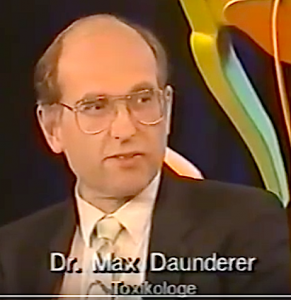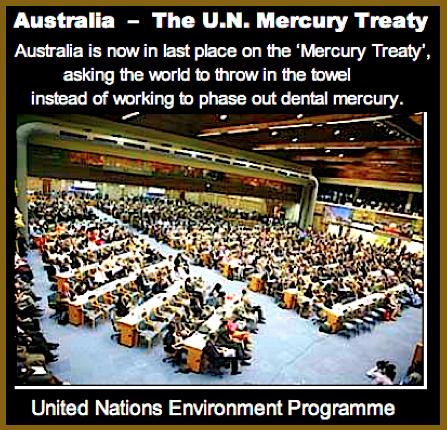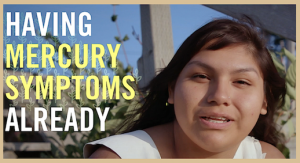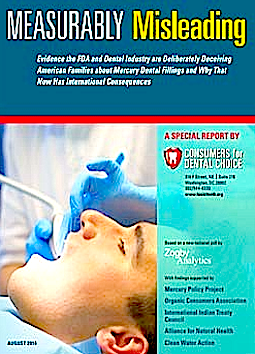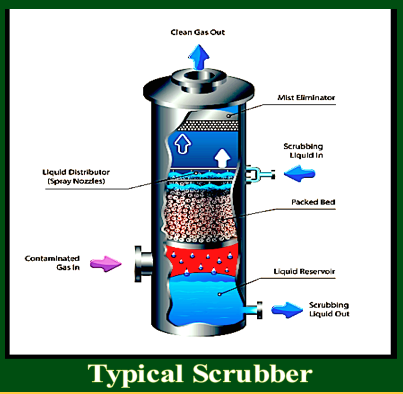The New York University College of Dentistry recently
announced it will no longer allow amalgam use in its clinics.
Come on ADA – it is time to get with the science!
Last update – 2nd June 2021
Dental Fillings Containing Mercury Now Banned in European Union
Original→ HERE ←
The Government of the United Kingdom on Friday 23 March 2018
deposited its instrument of ratification, becoming the 91 Party to the
Minamata Convention on Mercury that entered into force in August 2017.
The ratification followed that of Dominican Republic bringing to seven the
number of ratification in 2018. The ratification brings to 91 countries
that have ratified the Convention out of the 128 that signed it.
Full text → HERE
[ Translated from German ]
AMALGAM – Patient Information – Dr. Max Daunderer
“Effluent Limitations Guidelines and Standards for Dental Offices”
Mercury & Toxic Metal Effects on Kidneys, Urinary System & Fertility
Health Effects from Personnel Exposure to Mercury Vapour from Dental Amalgam
Specialising in the removal, separation & containment of dental amalgam.
Equipment ↓
Mercury Separation
The Hazardous Waste Regulations which came into force in
2005 in England and Wales and it classified all
dental amalgam as ‘hazardous waste’
More on Mercury separation
Mercury – Mercola – Autism – 2020
UNITED NATIONS ENVIRONMENT PROGRAMME
Mercury is a potent neurotoxin that can harm the brain, spinal cord, kidneys and liver.
It is used throughout health care in a variety of products including thermometers, sphygmomanometers, DENTAL AMALGAM, laboratory chemicals and preservatives such as thimerosal,✺ cleaning agents, and various electronic devices such as fluorescent lamps and computer equipment. The cumulative usage, spills, breakages and disposal of these products makes the health care sector a significant contributor of mercury pollution in the environment. Fortunately, it is relatively easy to phase out the use of mercury because of the many affordable, accurate and safer alternatives that exist for nearly all uses of mercury in health care.
Editor’s comment:
The United Nations Mercury Treaty is under
threat from the vaccine and dental lobbies.
 HERE
HERE
Charlie Brown discusses breakthroughs in establishing mercury-free
dentistry worldwide, and the progress made at The 4th World Health
Organization Mercury Treaty meeting in South America. ↓
→ Download Interview Transcript ←
CONSUMERS FOR DENTAL CHOICE
Shakes up the Debate on Dental Mercury
Story at-a-glance:
-
Amalgam is an archaic, dangerous dental practice left over from the US Civil War Era and is driven entirely by profits, without regard for human health
-
A landmark economics report reveals that after environmental costs are taken into account, amalgam is significantly more expensive than the non-mercury alternatives. In fact, the real cost of an amalgam filling is up to $87 more than a composite filling after the environmental costs of each material is considered
-
Another recent report by the European Commission recommends phasing out dental amalgam to reduce mercury pollution, which threatens the health of the environment, wildlife, and humans
-
Among the advances toward mercury-free dentistry, the New York University College of Dentistry recently announced it will no longer allow amalgam use in its clinics, nor will NYU require students to perform competency examinations for amalgam
Charlie Brown discusses the latest breakthroughs in establishing mercury-free dentistry worldwide, and the progress made at the 4th World Health Organization Mercury Treaty meeting in South America.
Download Interview Transcript
 A little slow to start- but very in-depth-Recommended.
A little slow to start- but very in-depth-Recommended.
Dr. Mercola Interviews Dr. Shade about Mercury
Still Carrying Around This Potent Neurotoxin Next to Your Brain?
CONSUMERS FOR DENTAL CHOICE
By Charlie Brown
“I do not approve the practice of any who use mercury or quicksilver as an ingredient for stopping teeth, and would not privately recommend any one to go to such.”– Eleazar Parmly, M.D. Dr. Eleazar Parmly’s warning about the dangers of amalgam fillings was not issued in 2012…nor even in 1912… He spoke these words way back in 1845.
Over 150 years later, health professionals still voice those same concerns about amalgam –
a product that is 50 percent mercury by weight. Over 150 years later, some dentists (albeit an ever-dwindling number) still claim that mercury is safe in people’s mouths.
Over 150 years later, even children are still subjected to the unnecessary exposure to mercury fillings.
ENOUGH IS ENOUGH…
The time for debate is over. Countless studies, reports, and articles now conclusively prove that dental mercury is dangerous in the environment.
And Consumers for Dental Choice is working with our colleagues from the dental, medical, and environmental sectors to make sure everyone knows it.
How Dental Mercury Harms Your Health
Even if You Don’t have Amalgam —
If you subscribe to Dr. Mercola’s newsletter, by now you know that mercury is never safe –
it is a neurotoxin, a reproductive toxin, and absolutely unneeded in 21st century dentistry. When you’ve been given a choice, you choose mercury-free fillings for your teeth and for your children’s teeth. So are you safe from dental mercury?
Unfortunately, no. Dental mercury is so toxic in the environment that it affects our whole planet…our nations…our communities… and individuals.
HERE’S HOW:
Amalgam fillings are one of the largest consumer uses of mercury in the world.
Between 313 and 411 tons of dental mercury are consumed each year.
In fact, the demand for dental mercury is higher than the demand for almost all other mercury products – more than lighting (120-150 tons), electrical devices (170-210 tons), and measuring devices like thermometers (300-350 tons).
As other mercury products are being phased out, amalgam is fast becoming the largest source of mercury pollution from products.
Some dental mercury is dumped directly from the dental office into the environment.
But most dental mercury walks out of the clinic in people’s teeth. From there, dental mercury enters the environment by numerous unsound pathways.
FOR EXAMPLE, DENTAL MERCURY IS POLLUTING:
AIR – from cremations, dental clinic emissions, sludge incineration, and respiration; and
LAND – via landfills, burials, and fertilizer.
WATER – via dental clinic releases that go down the drain and human waste;
Once in the environment, dental mercury can convert to its even more toxic form: methylmercury ♦♦
.
Ever wonder where all that mercury in fish and seafood comes from?
Mercury fillings are one source of mercury contaminating the fish and seafood that we eat.
The environmental health effects of dental mercury are well known: brain damage and neurological problems, especially for children and the unborn babies of pregnant women.
♦♦ Methylmercury – “CH3Hg+, organic form of mercury and the form of mercury that is most easily bioaccumulated in organisms; a neurotoxin.” –
It accumulated within organisms faster than it’s eliminated) and biomagnifies (increases in concentration as it travels up the food chain).”
How Consumers for Dental Choice is Fighting for
Your Right to a World Free of Dental Mercury
Two years ago as the mercury treaty negotiations loomed, ‘Consumers for Dental Choice’ started highlighting the environmental harms caused by amalgam. This powerful approach is paying off at the mercury treaty sessions — and turning the tide in nations around the world.
AMONG OUR RECENT STEPS FORWARD
-
Citing the upcoming mercury treaty specifically, as well as the environmental concerns we too have been voicing, the New York University College of Dentistry announced a new “amalgam policy” to its students: NYU will no longer recommend dental amalgam as the primary posterior tooth restorative… nor will NYU require students to perform competency examinations for amalgam…nor will NYU allow amalgam use in its clinics unless students obtain faculty permission for a specific case. These measures take NYU closer to the ultimate goal: to become “amalgam-free.”
-
Across the Atlantic, we had equally exciting news. The European Union had hired a consultant to advise it on what to do about amalgam. Our World Alliance for Mercury-Free Dentistry teamed with European Environmental Bureau, Zero Mercury Working Group, and Non Au Mercure Dentaire to submit information and to testify. The consultant now recommends a total phase-out of amalgam in the 27 nations of the E.U.1 — for the same environmental reasons our team has been explaining. Much work remains to be done here, but we are already mobilizing our forces for that battle.
-
While our opponent was trying to turn the 4th mercury treaty session (held in Uruguay) into a never-ending debate on health, we succeeded in keeping amalgam in the draft treaty by emphasizing amalgam’s known environmental harms and by offering practical solutions. As a result of this environmental strategy, our support from government officials and influential organizations from around the world continues to grow.
AMALGAM: ONE OF THE COSTLIEST DENTAL OPTIONS AVAILABLE
‘Consumers for Dental Choice’ is fighting so that every child can grow up in a dental mercury-free world. To do this, we are working with top experts to highlight the dangers –and high cost – of mercury fillings.
For example, we commissioned Brussels-based Concorde East/West, an international consulting firm that provides research to government agencies, to study the cost of dental mercury compared to the costs of mercury-free fillings. The landmark economics report The Real Cost of Dental Mercury2 (2012) reveals that after environmental costs are taken into account, amalgam is significantly more expensive than the non-mercury alternatives.
In fact, the real cost of an amalgam filling is up to $87 more than a composite filling after the environmental costs of each material is considered. Co-released by Consumers for Dental Choice with the Mercury Policy Project and the European Environmental Bureau, the report goes on to explain that both the environment and society are adversely impacted over “the whole life cycle of dental amalgam – mercury production, preparation of filling materials, removal of old fillings and placement of new ones, environmental and health impacts from mercury recycling, discharges to wastewater, solid waste disposal, emissions from crematoria and releases from cemeteries.”
The solution: “phasing out amalgam as a dental restorative material and switching to mercury free alternatives.” The pro-mercury dental associations have long spread the myth that mercury fillings are cheaper than the many mercury-free options such as composite.
As stated by Charlie in the featured interview:
“The reason the pro-mercury dentists use amalgam is the profits.
They make more per filling, per chair, per day…
They do this because they don’t pay for the environmental damage.
It’s the rest of us who have to pay for the huge environmental damage
caused by the irresponsible pro-mercury dentists.”
Now, we are prepared to counter them with hard numbers.
So who pays the high costs associated with dental mercury pollution?
-
Taxpayers, who pay for the clean-up of dental mercury
-
Governments, who pay the administrative costs of dental mercury pollution clean-up
-
Fishermen, who lose income when dental mercury contaminates seafood
-
Funeral home owners, who pay for abatement equipment to address dental mercury from crematoria
-
Landlords, who are left with mercury in dental clinic pipes
-
Farmers, who cannot use [sewerage] sludge contaminated by dental mercury as fertilizer
-
Environmentally-responsible dentists, who are at a competitive disadvantage because they do not use mercury
-
Manufacturers of alternatives, who are at a disadvantage against competitors selling polluting mercury products
-
Job seekers, who lose opportunities for work making, developing, and distributing the mercury-free alternatives to amalgam
-
Wildlife, which is contaminated by dental mercury pollution
-
Tourism workers, who lose revenue when the natural environment is harmed by dental mercury pollution
-
Pregnant and nursing women, whose unborn and newborn babies are exposed to dental mercury pollution
-
Children and parents, who pay for neurological damage resulting from dental mercury pollution
European Commission Recommends Phasing Out Amalgams to ‘Save The Environment’
As mentioned earlier, a recent report created by the BIO Intelligence Service (BIOS)3 for the European Commission recommends phasing out dental amalgam and mercury in button cell batteries by 2018 in order to protect the environment from continued devastating harm. According to the authors, dental amalgam is “a significant contributor to overall EU environmental emissions of mercury from human activities.” The situation is identical in the US.
ACCORDING TO THE REPORT
“The current levels of mercury pollution in the EU are such that all the EU population is exposed to mercury above the natural background level and certain population groups such as high-level fish consumers, women of childbearing age and children are subject to high risk levels, principally due to their high exposure and/or high vulnerability to mercury in the form of methylmercury, which is ingested through the diet.
This presents a risk of negative impacts on health, in particular affecting the nervous system and diminishing intellectual capacity.
There are also environmental risks, for example the disturbance of microbiological activity in soils and harm to wildlife populations. The effects of mercury releases on the integrity of the ecosystem are substantial. Various species, especially eagles, loons, kingfishers, ospreys, ibises, river otters, mink and others that rely on fish for a large part of their diet, have been observed to suffer adverse health and/or behavioral effects.
Observed disorders such as effects on the muscles and nervous system, reduced or altered mating habits, ability to reproduce, raise offspring, catch food and avoid predators have been demonstrated to affect individual animal viability and overall population stability.
According to calculations based on the critical load concept, more than 70 percent of the European ecosystem area is estimated to be at risk today due to mercury, with critical loads of mercury exceeded in large parts of western, central and southern Europe.”
HOW YOU CAN HELP FIGHT DENTAL MERCURY
Right now, you can help progress against dental mercury in two ways:
1.) Write a letter to the US Environmental Protection Agency (EPA), asking them to take action against harmful mercury pollution, and
2.) Make a donation to Consumers for Dental Choice, to help them fight for your right to mercury-free dentistry
EPA Administrator Lisa Jackson has done more to protect us from mercury than all other EPA administrators put together. She has written strong rules addressing mercury in air pollution. When you write, please thank her for her diligent work against mercury, and urge her to turn her attention now to dental mercury, as it is a major source of mercury in the environment.
Please remember that the EPA does not regulate the safety of health products, so do not discuss how amalgam in the mouth is damaging. The EPA’s role is to keep toxins out of the environment, so focus your correspondence on the environmental impact of dental mercury. This is where she has the authority to act.
Actual letters in the US mail have more impact that emails, so we encourage you to write and mail a letter! Please send it to:
Lisa Jackson, Administrator Environmental Protection Agency 1200 Pennsylvania Avenue, N.W. Washington, DC 20460
If you send an email, send it to Administrator Jackson at: Jackson.LisaP@epa.gov. To get noticed, emails need a good subject line; we recommend something like “Take action against dental mercury.”
Consumers for Dental Choice and its allies have made amazing progress against this primitive, polluting mercury product, but the battle is not won yet – dental mercury is still being dumped in nations all around the world… and in your own community. Will you please consider a donation to Consumers for Dental Choice, a 501(c)(3) non-profit organization dedicated to advocating mercury-free dentistry?
Donations are tax-exempt and can be made online at www.toxicteeth.org.
Checks can be mailed to:
Consumers for Dental Choice 316 F St., N.E., Suite 210 Washington DC 20002
Mercury exposure in young adulthood & incidence of diabetes later in life
Our results are consistent with findings from laboratory studies
and provide longitudinal human data suggesting that people
with high mercury exposure in young adulthood may
have elevated risk of diabetes later in life.
Also from PubMed:
Mercury Exposure and Children’s Health
The Reproductive System, Fertility and Mercury
Mercury Is Toxic To ALL Living Organisms
And ⇓
Join Consumers for Dental Choice’s newsletter list
on ToxicTeeth.org or write to Charlie at Charlie@ToxicTeeth.org.
( The European Parliament’s Environment Committee voted overwhelmingly
to phase out all amalgam use by 31 December 2022. )
9 More Vaccine Ingredients
Diabetes: Causes, Natural Control, & the Mercury/Vaccine Factor
❝ AUSTRALIANS FOR MERCURY-FREE DENTISTRY ❞
Led by Dentist
✺ ❝ …Vaccine manufacturers, in order to store larger amounts of vaccine at a lower cost, offer “multi-dose units” while adding preservatives such as thimerosal ♦ to prevent contamination. That way doctors can open and close a vaccine container, inviting germs into the once-sterile solution, while assuring the public that those contaminants are quickly killed by the preservative. It saves money, while posing an undue risk to your health. But like many toxic preservatives it kills more than just bacteria and fungi; it can lead to extensive neurological damage in your children, and has even been implicated in autism… ❞
[Especially when the vitamin C levels are low.]
* Contains Mercury
♦ Thiomersal (also know as thimerosal in the United States) is a bacteriostatic preservative used in vaccines and other biologic products since the 1930s for several specific reasons: as a broad bacteriostatic agent; as a preservative; and to inactivate specific moieties. Its concentration in most vaccines results in delivery of about 25 µg of thiomerosal in each dose administered. Importantly, thiomerosal is only 50% ethylmercury by weight. Many regulators, including the United States Code of Federal Regulations, require the addition of a preservative to multi-dose vaccine vials. Multi-dose vials have several advantages. They are cheaper than single dose formulations, and because more doses can be stored in a smaller space, they allow for decreased storage costs across the cold chain substantial for large immunization programs.
Infants in 120 countries rely on multi-dose vaccines containing Thiomerosal to protect them against life-threatening diseases… Full text → HERE
Editor’s comment:
Coca-Cola seems to be able to deliver millions of individual glass vials [sorry] bottles, around the globe at a profit! – In 2013, Coke products could be found in over 200 countries worldwide, with consumers downing more than 1.8 billion company beverage servings each day… This makes the Thiomersal augment look somewhat pathetic.
THE TWIN TOXIC DANGERS OF MERCURY AND FLUORIDE
❝ … I have always liked all my dentists, trusting their competence more than doctors, but when I began to understand the twin dangers of fluoride and dental mercury amalgam I began to see that the entire profession has been duped, and that goes for most graduates of medical school. We first-world people like to think that our universities and medical schools are centers of higher learning and intelligence, but the fact is that they are intense conditioning machines that forcefully mind shape the brains of their vulnerable students who start out with good intentions… ❞
The University is not engaged in making ideas safe for students.
It is engaged in making students safe for ideas.
— Clark Kerr —

Visit the Mercola Video Library
Still Carrying Around This Potent Neurotoxin Next to Your Brain?
→ FACTS ABOUT MERCURY & DENTAL AMALGAM – Bernard Windham ←
“…toxic metals such as mercury, lead, cadmium, etc.
have been documented as neurotoxic, immunotoxic,
reproductive/developmental toxins that according to
U.S. Government agencies cause adverse health
effects and learning disabilities to millions
in the U.S. each year…”
Mercury Canada
Mercury USA

VERY SHORT VIDEO ⇒ HERE
→ International Academy of Oral Medicine & Toxicology ←
Thank you for supporting Mercury-Free Dentistry!
New mercury standards –EPA [USA]
Court Upholds EPA’s Mercury Emissions Standards for Power Plants
Read more:
http://www.care2.com/causes/court-upholds-epas-mercury-emissions-standards-for-power-plants.html#ixzz2zDeeAXdG
In 2011, the Environmental Protection Agency issued the first ever national standards to reduce mercury and other toxic air pollution from coal and oil-fired power plants. Since the implementation of the 1990 Clean Air Act Amendments, the EPA has been tasked with issuing regulations to regulate damaging pollutants released into the air. In 1990, there were three major industries that emitted two-thirds of mercury and other toxic emissions: medical waste incinerators, municipal waste combustors, and power plants.
Mercury is extremely toxic and linked to neurological and developmental problems, and even death. When it is emitted into the air, it gets trapped into precipitation and returns into the water supply. Once it ends up in lakes and streams, it turns into a more toxic organic form that permeates the food chain by being absorbed in the tissue and muscles of fish — and all that eat them. Pregnant women and children are most susceptible to the dangers of mercury, which can lead to nervous system damage, respiratory illnesses and birth defects.
Having been subject to regulations for a number of years, medical waste incinerators and municipal waste combustors had reduced their mercury emissions by 98 percent and 96 percent respectively by 2005. At the time of the new regulations in 2011, power plants were the source of 50 percent of air-borne mercury emissions, 75 percent of acid gases and nearly 60 percent of toxic metals. Many of these plants are located near major water supplies.
A coalition of state and industry representatives sued the EPA, ♠ claiming that they did not have the authority to issue the regulations and that they failed to consider the costs of implementing the new standards. The economies of the states that fought the rules were heavily dependent on the coal and energy industry. The coalition said being forced to comply with the regulations would disrupt the power supply as many of the older plants would have to shut down and there would be a risk of losing more than a half-million jobs.
On Tuesday, an appeals court upheld the regulations.
The court rejected the industry’s argument that the EPA didn’t have authority, saying that Congress had relegated the authority to the EPA to determine which types of things would be deemed a hazard to public health and act accordingly. Furthermore, they were convinced that the EPA had acted appropriately based on the ample evidence of the health risks of mercury. As for the costs, the court said the EPA had acted properly by making the decision based on health risks and not compliance costs and that the agency had shown that the benefits outweighed the costs.
The standards will prevent about “90 percent of the mercury in coal burned in power plants being emitted to the air; reduce 88 percent of acid gas emissions from power plants; and reduce 41 percent of sulfur dioxide emissions from power plants.” The nation’s more than 600 coal and oil-fire power plants will have until April 2015 to comply, and the law allows for states to grant an additional year for technology installation. Thus far the coal industry has invested $130 billion, and anticipates spending an additional $100 billion over the next decade on “clean coal technology.” An industry coalition has said that many power plants have already been retired due to the costs and expects additional ones to go offline by the deadline, which they say risks disruption to the energy supply of the nation.
The EPA called the ruling a “a victory for public health and the environment” and notes that in EPA’s 40 year history, the Clean Air Act has not impacted power companies’ ability to keep the lights on in communities across the United States.
And they can do so without polluting the air and water.
♠ Mercury does not affect everyone equally
Children are highly susceptible to harm from mercury because their bodies are developing at such a rapid rate. The most recent estimates by the EPA indicate that one in six U.S. women of child-bearing age has mercury levels in her blood high enough to put her baby at risk.
1 ) That means as many as 630,000 infants are born in the U.S. every year with unsafe mercury levels, double what the EPA previously estimated.
2 ) These children face the risk of damage to their nervous system, which can result in delayed onset of walking and talking, cerebral palsy and mental retardation…
Read more:→ EPS Mercury emission standards for power stations.
MEASURABLY Misleading
Good new policy – July 2014 → HERE
-
Amalgam damages teeth: Amalgam requires the removal of more healthy tooth tissue, weakens tooth structure, and can crack teeth as it expands and contracts – leading to higher dental bills later.
-
Amalgam exposes people to mercury: Dental amalgam releases mercury, a neurotoxin. Children, the unborn, the hypersensitive, and dental personnel are especially vulnerable to the toxic effects of mercury.
-
Amalgam pollutes our environment: Dental amalgam constitutes the largest amount of mercury in use in the United States today, and most of this mercury ends up polluting our air, soil, and water. Mercury pollution indisputably can cause health problems, especially for children and the unborn.”
-
Declared Safe for Centuries, Yet It Slowly Ravages Your Brain
~ ODD INFO ON MERCURY ~
When mercury forms an amalgam with aluminum, the oxide layer that protects aluminum from oxidizing is disrupted. This causes aluminum to corrode. Mercury is a profound, systemic and long-term poison for humans, but also for other organisms. Putting mercury into the environment is a very serious issue. About half the mercury that enters the environment every year comes from volcanic eruptions and other geological processes. The other half is released by mankind. Tooth fillings and smashed bulbs only account for a fraction of the 2,000 tonnes of mercury released by humans into the environment each year. About a quarter is a by-product of power generation.
Coal-fired power stations pump mercury into the atmosphere.
[ Coal burning chimneys need to be fitted with ‘SCRUBBERS’ ]
A MUCH FUN – MUST VIEW
! MAKE YOUR OWN FLU SHOT !
↑ A short fun U-tube ↑
COMPREHENSIVE INFORMATION ON MERCURY
…Fatigue, anxiety, depression, odd paresthesias, weight loss, memory loss,
and difficulty concentrating, these are the symptoms of low-grade
chronic mercury exposure described by the investigators…
Recommended reading ↓
“Mad as a Hatter”
Lewis Carroll’s Alice’s Adventures in Wonderland- 1865.




